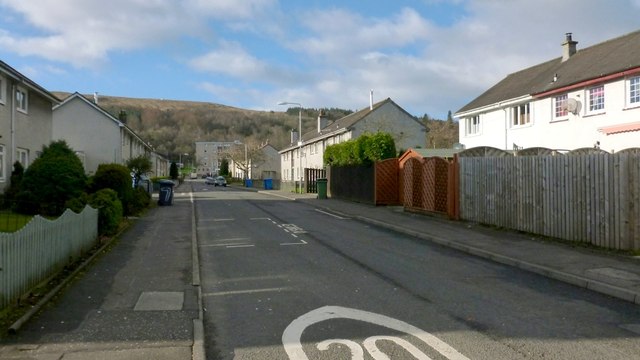Tullichewan Drive
Introduction
The photograph on this page of Tullichewan Drive by Lairich Rig as part of the Geograph project.
The Geograph project started in 2005 with the aim of publishing, organising and preserving representative images for every square kilometre of Great Britain, Ireland and the Isle of Man.
There are currently over 7.5m images from over 14,400 individuals and you can help contribute to the project by visiting https://www.geograph.org.uk

Image: © Lairich Rig Taken: 6 Feb 2013
This is the main road leading into Tullichewan, an area of housing on the western side of Luss Road. Tullichewan Road more or less bisects the estate. The name has been associated with this area for a long time, and there used to be a Tullichewan Castle nearby: see, for example, Image In connection with that name, some nineteenth-century authors(*) used the form Tilly-Colquhoun. However, to my mind, that has the appearance of folk etymology; in any case, it is not borne out by early forms of the name. It is quite likely that it contains the Gaelic element "tulach" (knoll, hillock), but the overall meaning is uncertain. (Compare the name Tullochan, at Image, about 5.5 km NNE of here.) By way of illustration, the following are authentic older spellings (although not necessarily the very oldest). The Lennox Cartulary has a charter by Earl Malcolm (before 1333), in which the spelling is "Tulochewyne", quite close to the present form. The following later examples are from the Register of the Great Seal of Scotland (RMS), with the year of the relevant Latin charter given in parentheses: "et tribus Tullequhwnys" (1507); "terras de tribus Tulliquhewnys" (1512); "Tullichquhoneis" (1545); "Tullichewynnis" (also 1545). The various RMS spellings appear to be plural in form, "Tullichewans". In fact, the Latin entries from 1507 and 1512, quoted above, both refer to "the lands of the three Tullichewans". [(*) For example, Joseph Irving, in his "History of Dumbartonshire" (1860), writes that "in the north-west part of Bonhill parish are the lands of Tillichewan, or Tilly-Colquhoun".]
Image Location







